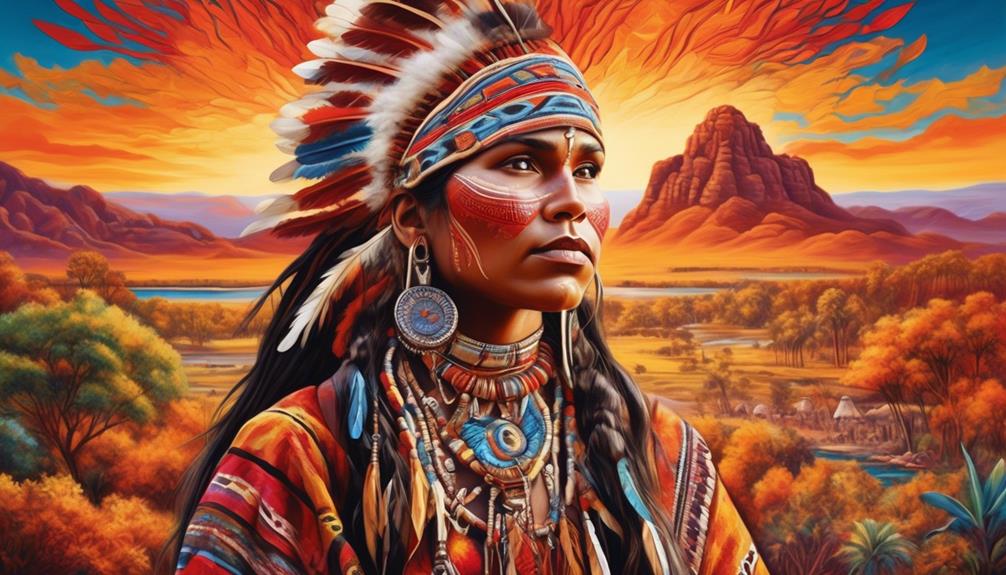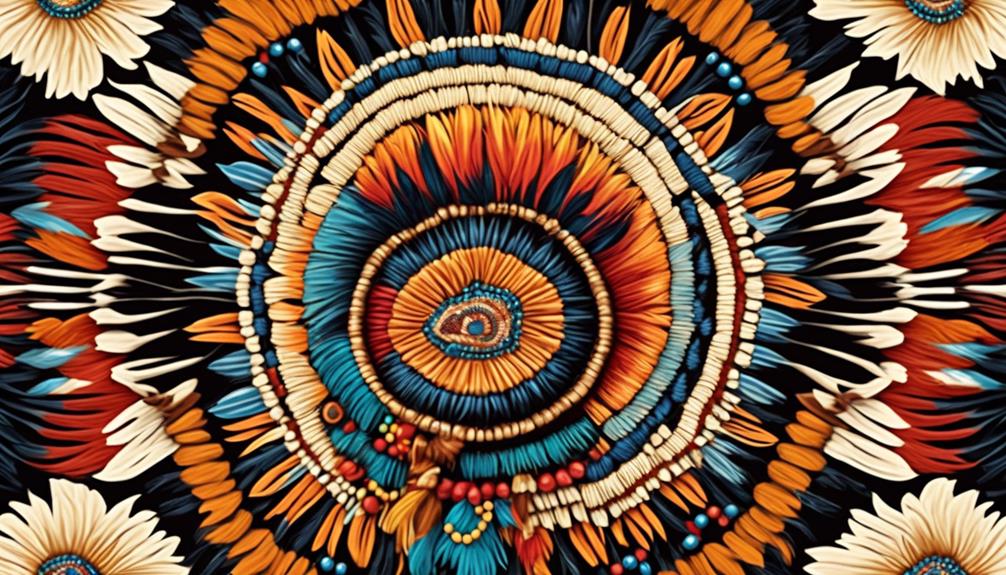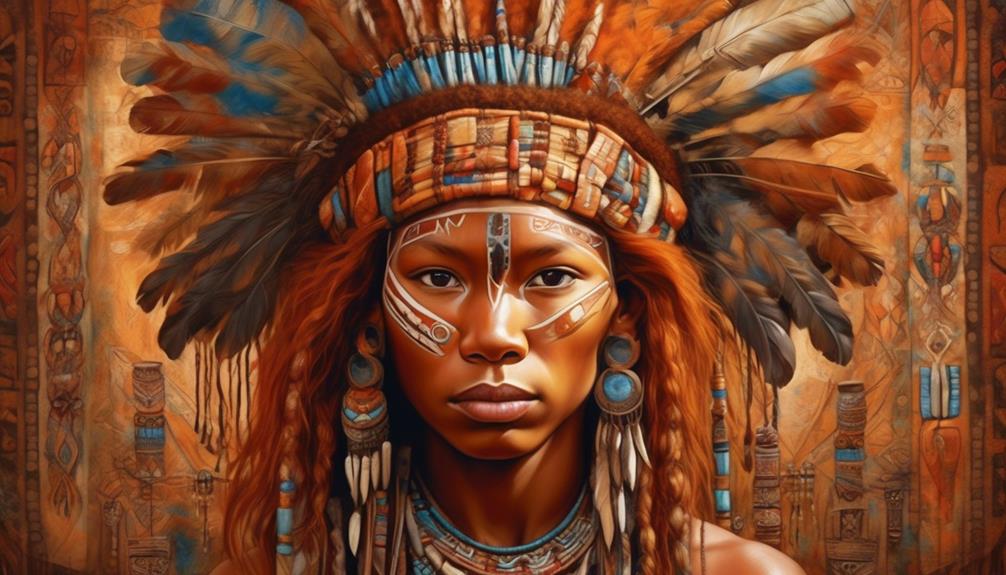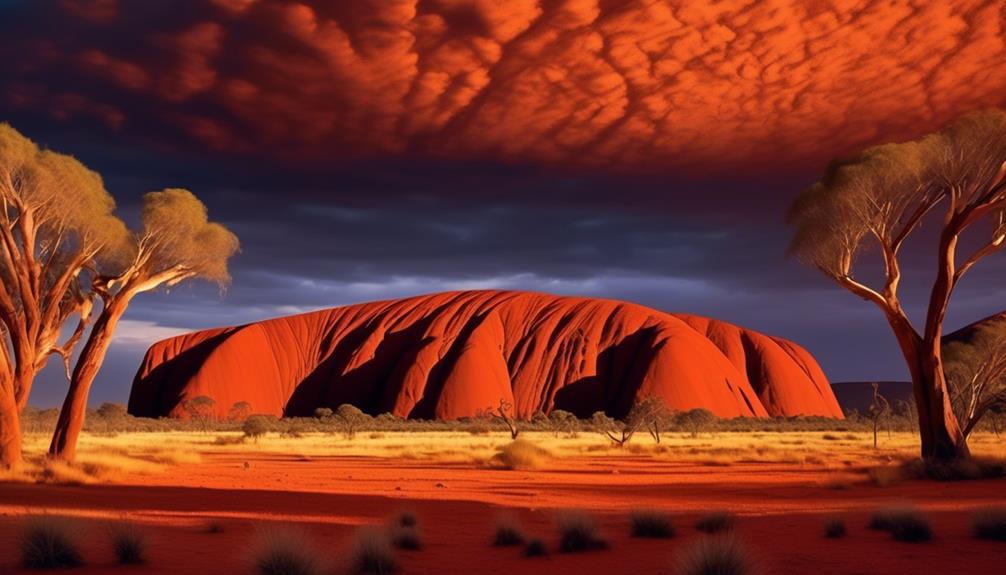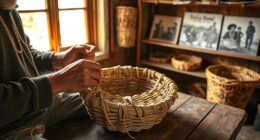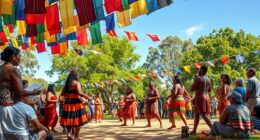Have you ever seen the mesmerizing and intricate dot paintings created by Aboriginal Australians? Do you know the deep significance behind each carefully placed dot?
While it's easy to appreciate the visual appeal of this art form, there's a whole world of cultural history and storytelling waiting to be unraveled.
Let's explore the origins, symbolism, techniques, and modern interpretations of Aboriginal Dot Art, and discover the global impact it has had on the art world.
Key Takeaways
- Aboriginal Dot Art is deeply rooted in the rich cultural traditions and spiritual practices of the indigenous peoples of Australia.
- It conveys stories, traditions, and spiritual beliefs of Aboriginal communities through layers of symbolism and meaning.
- Traditional techniques involve using natural pigments derived from plants and minerals, and dotting is done using various tools like thin sticks, handmade brushes, or fingers.
- Aboriginal Dot Art has evolved to incorporate innovative techniques and materials, reflecting the evolving nature of Aboriginal culture and engaging with global art movements.
Origins of Aboriginal Dot Art
The origins of Aboriginal Dot Art can be traced back to the rich cultural traditions and spiritual practices of the indigenous peoples of Australia. This unique form of art is deeply rooted in the Aboriginal culture, reflecting the sacred stories, rituals, and connection to the land.
The artistic evolution of dot painting is intertwined with the Aboriginal people's understanding of their environment, history, and Dreamtime, the period of creation in their belief system.
Aboriginal Dot Art has a long history, with its roots in ancient rock art and ceremonial body painting. Over time, it has evolved from traditional forms of expression to contemporary art, gaining recognition and appreciation worldwide. The intricate patterns and symbols used in dot painting not only convey stories and beliefs but also serve as a way of passing down cultural knowledge from one generation to another.
The artistic evolution of dot painting mirrors the resilience and preservation of Aboriginal culture amidst colonization and modernization. It has become a powerful medium for asserting indigenous identity and sharing the richness of Aboriginal heritage with the global community.
Symbolism and Meaning in Dot Art
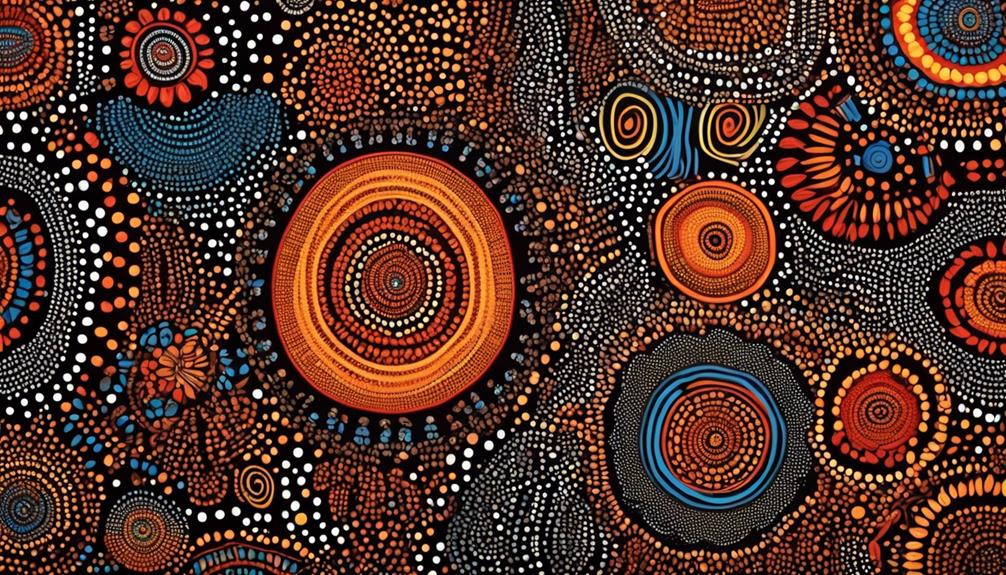
Embedded within the intricate patterns of Aboriginal Dot Art are layers of symbolism and meaning that offer a profound insight into the cultural and spiritual heritage of the indigenous peoples of Australia. The use of symbols in dot art holds deep cultural significance, serving as a form of artistic expression that communicates the stories, traditions, and spiritual beliefs of Aboriginal communities. These symbols are not merely decorative; they carry the weight of traditional storytelling and convey a profound spiritual connection to the land, ancestors, and the Dreamtime.
To provide a deeper understanding, let's explore some common symbols found in Aboriginal Dot Art:
| Symbol | Meaning |
|---|---|
| Circle | Represents a waterhole or campsite, often used to depict community and gathering places. |
| Dots | Symbolize stars, sparks, or ritual body painting, signifying the connection between the earthly and spiritual realms. |
| U-shapes | Depict people sitting around a fire, emphasizing the importance of community and storytelling. |
| Wavy Lines | Symbolize water sources or travel paths, reflecting the significance of these elements in Aboriginal life. |
The use of these symbols in dot art not only captures the essence of Aboriginal culture but also serves as a powerful medium for preserving and passing down traditional knowledge and spiritual wisdom.
Techniques and Tools for Dot Art
Exploring the traditional techniques and specialized tools used in creating Aboriginal Dot Art offers valuable insight into the intricate process of crafting these culturally significant artworks. The dot art tools and techniques are deeply rooted in the traditions and beliefs of the Aboriginal culture, playing a crucial role in the creation of these mesmerizing artworks.
- Traditional Techniques: Aboriginal Dot Art is traditionally created using natural pigments derived from plants and minerals. The artists use a technique called 'dotting,' where paint is applied to the canvas using various tools such as thin sticks, handmade brushes, or even their fingers. The meticulous process involves layering and stippling to build up intricate patterns and symbols, resulting in the mesmerizing visual effect characteristic of this art form.
- Specialized Tools: The tools used in creating Aboriginal Dot Art are often handmade and specifically designed for dotting. These can include tools such as bamboo skewers, which allow for precise dot placement, as well as fine-tipped brushes made from natural materials. The use of these specialized tools not only demonstrates the significance of the art form but also contributes to the unique texture and depth of Aboriginal Dot Art.
Understanding the traditional techniques and specialized tools provides a deeper appreciation for the skill and cultural significance embedded within Aboriginal Dot Art.
Contemporary Interpretations of Dot Art
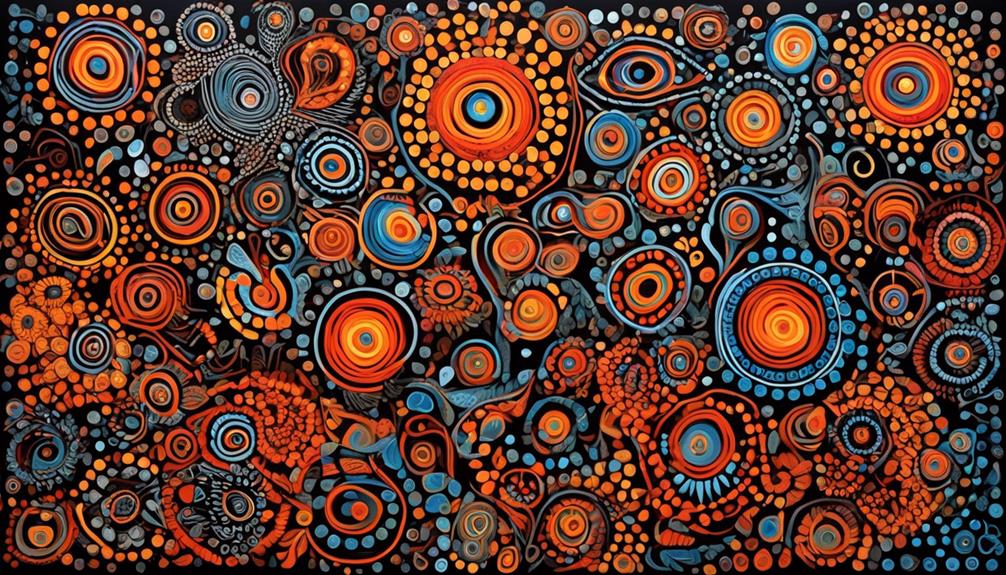
In contemporary art circles, artists have reimagined the traditional Aboriginal Dot Art, infusing it with innovative techniques and modern perspectives to create captivating interpretations. These modern adaptations often reflect the evolving nature of Aboriginal culture and the intersection between tradition and contemporary influences.
Artists are incorporating new materials and experimenting with different styles to bring a fresh approach to the traditional dot painting. This contemporary interpretation of dot art not only showcases the artists' creativity but also serves as a means of preserving and expressing cultural significance in a rapidly changing world.
The use of vibrant colors, intricate patterns, and diverse subject matters in these reinterpretations breathes new life into the art form, appealing to a wider audience while maintaining its cultural roots. Moreover, contemporary interpretations of dot art provide a platform for Indigenous artists to engage with global art movements, fostering cross-cultural dialogue and understanding.
Through these modern interpretations, Aboriginal dot art continues to evolve, reflecting the ongoing resilience and relevance of Indigenous cultural heritage.
Global Impact and Recognition
The global impact and recognition of contemporary Aboriginal dot art is testament to its enduring significance in the cultural and artistic landscape, transcending geographical boundaries and captivating diverse audiences. Aboriginal dot art has had a profound global influence, with its mesmerizing patterns and stories resonating with people around the world. Its cultural significance is increasingly recognized and celebrated, not only for its aesthetic appeal but also for the stories and traditions it encapsulates.
The following are three key aspects that highlight the global impact and recognition of contemporary Aboriginal dot art:
- Artistic Fusion: Aboriginal dot art has influenced and been influenced by various art movements globally, creating a rich tapestry of cultural exchange and artistic fusion.
- Museum Acclaim: Major art institutions and museums worldwide have embraced Aboriginal dot art, showcasing its timeless beauty and cultural depth, thus furthering its global recognition.
- Economic Empowerment: The commercial success of Aboriginal dot art has provided economic empowerment to Indigenous communities, underscoring its global impact as a catalyst for socio-economic development.
The global influence and cultural significance of contemporary Aboriginal dot art continue to enrich the world of art and beyond, fostering understanding and appreciation for Indigenous traditions.
Frequently Asked Questions
What Are the Traditional Stories and Dreamtime Narratives That Inspire Aboriginal Dot Art?
Traditional stories and Dreamtime narratives are integral to Aboriginal art styles. These cultural interpretations provide a rich tapestry of inspiration for artists, connecting them to ancestral heritage and spiritual beliefs.
The narratives often serve as a visual representation of the deep connection between the land, people, and spirituality.
Through these stories, artists capture the essence of their cultural identity and pass down the traditions of their ancestors, creating a timeless legacy through their art.
How Do Different Aboriginal Communities Interpret and Use Dot Art in Their Cultural Practices?
Different Aboriginal communities interpret and use dot art in their cultural practices in diverse ways. The interpretation of dot art varies depending on the community's storytelling traditions and artistic inspiration.
It serves as a means of preserving cultural heritage and passing down traditional knowledge. Through this art form, different communities express their unique cultural identities and spiritual connections to the land.
The use of dot art reflects the deep significance of storytelling and cultural practices within Aboriginal communities.
Are There Specific Rules or Protocols for Creating and Using Dot Art Within Aboriginal Communities?
When creating dot art within Aboriginal communities, specific protocols are closely followed. These guidelines are deeply rooted in traditional stories and Dreamtime narratives, ensuring that the art accurately reflects cultural significance.
The intricate process of creating dot art requires adherence to these protocols, preserving the stories and customs passed down through generations. Understanding the importance of these rules is essential to respectfully engage with the rich cultural heritage embedded in Aboriginal dot art.
What Are Some Lesser-Known Artists or Art Styles Within the Aboriginal Dot Art Tradition?
When it comes to lesser known artists and unique styles within the Aboriginal dot art tradition, there's a rich tapestry to explore.
Some artists, like [Artist Name], have developed distinctive techniques and motifs that add depth to the tradition.
Understanding the cultural significance and authenticity of these artists' work can provide a deeper appreciation for the art form as a whole.
Exploring these lesser known aspects can lead to a more comprehensive understanding of Aboriginal dot art.
How Has the Commercialization of Aboriginal Dot Art Affected Its Cultural Significance and Authenticity?
The impact of commercialization on indigenous art is like a double-edged sword. On one hand, it brings wider recognition and economic opportunities. On the other hand, it risks cultural appropriation and dilution of authenticity.
The commercialization of Aboriginal dot art has significantly affected its cultural significance and authenticity, with mass production and appropriation leading to the loss of traditional meanings and techniques. This has sparked important discussions about preserving and respecting indigenous art forms.
Conclusion
As you explore the world of Aboriginal dot art, you uncover a rich tapestry of culture and history, much like peeling back the layers of an ancient, intricate mosaic.
The symbolism and techniques used in this art form offer a glimpse into the traditions and stories of the Aboriginal people, while the contemporary interpretations and global recognition demonstrate the enduring impact of their art on the world stage.
It's like discovering a hidden treasure that continues to captivate and inspire.
Mary is a passionate writer who brings creativity and a fresh perspective to our team. Her words have the power to captivate and inspire, making her an essential contributor to our content. Mary’s commitment to storytelling and dedication to promoting Indigenous culture ensures that her work touches the hearts of our readers. We’re fortunate to have her as part of our team.

